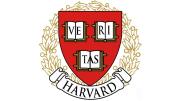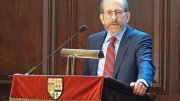Harvard today released its 2020 tax filings, covering fiscal year 2021 (July 1, 2020, through June 30, 2021), including information on the earnings of University leaders, and the accompanying Harvard Management Company (HMC) disclosure of senior employees’ compensation for calendar year 2020.
Compensation for the University’s Leaders
As was the case last year, the annual report of the most highly compensated University officials and employees reflects Harvard Business School’s (HBS) voluntary retirement incentive program for tenured faculty members; two members who elected to participate received reported compensation of nearly $2.0 million and $1.9 million, respectively, reflecting their final salaries and immediate vesting of lump-sum payments. Those anomalies aside (and excluding compensation to other faculty members), the most highly compensated officials are the expected ones among Harvard leaders:
Lawrence S. Bacow, president, $912,565, plus other compensation of $220,377 (principally the value of the University-provided official residence, Elmwood, and deferred retirement and other compensation)
Alan M. Garber, provost, $628,236, plus other compensation of $197,434 (again principally reflecting the value of a University-provided residence)
Brian Lee, vice president, alumni affairs and development, $762,375 plus other compensation of $66,169
Katie Lapp, executive vice president, $724,460, plus other compensation of $45,963 (Lapp announced yesterday that she would be stepping down from her Harvard position this summer.)
Updated May 16, 2022, 9:35 a.m.: The lower levels of compensation reported for Bacow, Garber, and Lapp compared to the prior year’s report likely reflect their decision, announced early in the pandemic, to voluntarily reduce their salaries by 25 percent; at least part of that period of compensation restraint would have been reported in this year’s tax filing, covered here.
Various deans (Harvard Medical School’s George Q. Daley, $860,271; Faculty of Arts and Sciences’ Claudine Gay, $608,967) were also among leading earners. Other senior administrators (vice president for finance and chief financial officer Thomas Hollister, vice president and general counsel Diane Lopez, vice president for public affairs and communications Paul Andrew, vice president for campus services Meredith Weenick—who will succeed Lapp as executive vice president, and vice president and University secretary Marc Goodheart) earned base compensation in a range from $391,928 to $522,752. All these officials received additional compensation for medical, retirement, and other benefits.
Two further items of note. Reflecting planned retirements (HBS dean Nitin Nohria) as well as retirements associated with the University’s pandemic-period incentive program (vice president and chief information officer Anne Margulies, vice president for human resources Marilyn Hausammann), there were several large payments that combined final-year salaries plus deferred compensation.
And for a second consecutive year, McKay professor of the practice of computer science and liaison to the chief technology officer David J. Malan appears on the highly compensated list, with total reported compensation of $1,412,660 (Corrected 11:45 a.m.: up from about $975,000 last year [erroneously reported as $929,000 previously]). He earned base compensation of $386,197, and other reportable compensation of $979,513. He is the creator and leader of the phenomenally popular Computer Science 50: “Introduction to Computer Science.” It is among the largest courses at Harvard; has been cloned at Yale; frequently leads enrollments, likely including students paying to earn credentials and certificates for their work, on edX (where enrollment soared during the pandemic); and has other iterations, including for business and M.B.A. learners. His additional reportable compensation presumably derives from some of those other extensive activities—and is an interesting sign of the implications of future extensions of Harvard, and its faculty members, into online-learning ventures.
The Endowment Managers
At HMC—the University subsidiary which invests endowment and other financial assets—a multiyear restructuring begun late in 2016 was largely completed during 2020 (as explained here), so the data reported today should be the first largely scrubbed of unusual items associated with that protracted transition in personnel, strategies, and most of the major redeployments of assets. Calendar-year 2020 compensation was reported for the following HMC employees:
N. P. Narvekar, chief executive officer, $1,002,336—down sharply from $6.3 million reported in the prior year, but principally because of deferral of salary and incentive-based compensation into future years. Adjusting for that deferral, Narvekar’s calendar 2020 compensation was $6.24 million. Richard Slocum, chief investment officer, earned a reported $803,578, but again, that reflects deferrals; his total compensation, adjusted for those deferrals, was $4.99 million.
Sanjeev Daga, chief operating officer, $6,020,756 (including $1.03 million in reimbursement for compensation forfeited when he moved from Columbia’s investment team to HMC; excluding this amount, Daga’s compensation was $4.99 million, equal to Slocum’s)
Elise McDonald, generalist team, $3,702,317
John Shue, generalist team, $3,499,650
Kate Murtagh, chief compliance officer, $2,252,656
Hans Plukas, generalist team, $2,016,592
The HMC compensation figures reported today derive from the period including the second half of fiscal year 2020, when returns on endowment assets were 7.3 percent, and the first half of the phenomenal fiscal year 2021, when returns were 33.6 percent.
As reported then, Harvard’s fiscal 2021 returns lagged behind those of some peer institutions—but investment skill is tested over longer time periods. Results in recent months have been adverse across many categories of investments as interest rates rise and equity and fixed-income asset values fall. Narvekar preaches the virtues of evaluating performance over complete market and economic cycles, and of structuring portfolios to avoid large losses (which of course depress long-term returns), so it will be interesting to compare HMC and peer performance next fall. Early reports suggest that many institutional investors have reported negative returns in recent quarters, and perhaps break-even results for the fiscal year to date. Stay tuned for Harvard’s results, and, allowing for the significant reporting lag associated with the University tax filings and HMC compensation disclosures, the longer-term effect on HMC managers’ performance-based pay in coming years.
Last year’s report on compensation, based on the Form 990 filings for fiscal year 2020, is available here.









